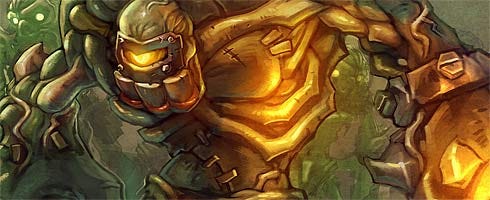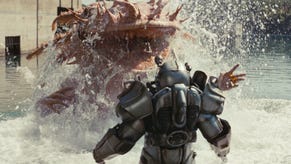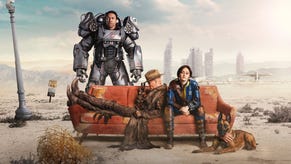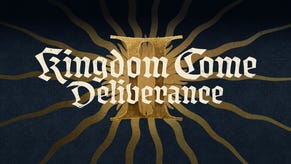Interview: Runic's Max Schaefer on Torchlight and Torchlight II
Runic Games is on the up. Having clocked more than 500,000 sales for 2009's universally-loved indie ation-RPG Torchlight on PC, the developer hit the big leagues this week with a place on CES's Microsoft keynote stage and confirmation of an XBLA version.
While the console outing has received a complete UI and control overhaul over the PC smash, Runic's rushing towards a "May" launch of Torchlight II on PC, replete with online co-op, overland areas and more.
We spoke with Runic co-founder Max Schaefer in December on the state of play for PC development in general, the original thinking behind Torchlight as a project and what we can expect from the much-anticipated sequel.
VG247: You had a real hit with Torchlight. What was it about the game that resonated so well with PC users? Do you think there was just a gap in the market for another point-and-click action RPG at the time?
Max Schaefer: Yeah. I was involved with the whole Diablo series as well, and the motivation was the same then as it was when we started making Torchlight, and that is, like you said, that there’s a gap in the market.
There are a million people out there trying to make WoW-killers, and the standard MMO genre is very, very crowded right now. For whatever reason, there seem to be precious few good action-RPG titles. That was the basis for why we wanted to make Torchlight to begin with.
Also we took a couple of gambles with Torchlight that I think paid off, and that was that people just want a fun game, and don’t so much care if it has multiplayer. Assuming there are people that will play a single-player RPG was the biggest risk.
But also we felt that in PC games in general, the projects have got too big, and too labourious, and they take too long and too much money to make. We figured that we could make a really fun, compelling game and only have to charge $20 for it - no subscription fees, no item sales or anything like that - and that people would be receptive.
I think they were, and I think that’s an approach that we’re going to continue to take as we go forward.
To expand on that, then, the climate at the moment, especially on PC, is seemingly very kind to mid-budget developers delivering games which are not quite so fully-featured but have a lower price and are more easily digestible. Torchlight’s a great example, and Minecraft’s another one. We’re seeing very big numbers for these games. Do you think this is because people have just got tired of spending too much money for games which are too big?
Max Schaefer: Right. And just from a business perspective, when you make these $50 million games, it’s so hard to make your money back that publishers are very conservative about what sort of games they’ll greenlight. So you get a lot of sequels, copycat games and conservative plays. When you come down to a rational budget and a rational team size, you really are freed to take more risk and do more creative things. I think Minecraft is a perfect example. I’m obsessed with Minecraft. I can safely say that Minecraft will slightly delay the shipping of Torchlight 2 [laughs].
It just proves that one guy can make a clever and compelling game. I hope we see more of it, because I think what the PC business really needs right now is more creativity, more responsiveness to customers and more fun, compelling titles. If we’re going to spend $50 million and take four years to make each game, we’re just not going to serve the market.
On the subject of lightweight, easily digestible games, part of Torchlight’s success was almost certainly down to the fact that it would basically run on anything. This is a tactic that Blizzard put to very good use with WoW back in the early days. Is it going to be a similar deal with Torchlight II?
Max Schaefer: Torchlight II runs on the same graphics engine and technology as Torchlight. Now, since there are more people on screen and there’s a little bit more happening, it won’t be identical in its performance, but it’ll be very, very close. Like you say, it really helped World of Warcraft a lot, and I think it has an even more profound effect to a game like Torchlight, for several reasons: firstly, if it runs on old machines, then the market is bigger; also, action-RPGs really benefit from a smooth frame-rate more than other game genres do. By going low-spec, your frame-rate goes up on your good machines as well. If you have a super-high-end gaming rig, Torchlight runs smooth as silk on it, and it just feels good.
Taking a low-tech approach has benefits in performance on any machine, not just running on low-end machines.
Also, not doing bump-maps and shaders and all this sort of stuff, means that we can make stuff faster and it’s easier to iterate. We actually get to spend more time polishing, and more time with the art direction, and more time iterating on the things we’re designing, because the production of the art assets is just a lot easier and faster.
It seems that taking this approach to development actually keeps you very nimble. Is this the sort of space you want to stay in? You don’t want to move towards higher-end graphics cards?
Max Schaefer: I think we’re definitely going to stay in this area. For one thing, we want to keep a small company; we don’t want to grow to be a thousand people like Blizzard. We don’t want to do five-year projects. We want to stay as a small team that does one thing at a time and focuses on it and does it quickly.
I think pretty much anyone in the game business has a least a small measure of attention deficit disorder, and as developers we certainly do as well. It’s certainly a lot more satisfying to get a project on the shelves in 11 months, as we did with Torchlight, than to spend five years on something that may or may not ever ship.
Talking about the game itself, then. Obviously, it’s built very closely to the Diablo II formula: were you very clear when you set out that you weren’t going to deviate from click, kill, loot, sell, in any way at all?
Max Schaefer: Yeah. I think that was the one area in which we were fairly conservative in our approach. We have a bunch of people on our team that have a proven and long history of making this sort of game. We know that we can do this sort of game well. We know that we can put out a compelling, fun product in this genre. Given that we were going off-board with a lot of the other approaches we were taking, it was the one area that we did want to be conservative and make sure we got right.
And I’m glad we did. Now that we’ve established the Torchlight franchise, and established the development tools and our team, let’s see what we can do with it now, see what other people who are making action-RPGs, who have a more labourious process and have bigger teams, can’t do. We want to be able to go places that maybe Diablo III won’t go. We’re a brand new company, and Torchlight is our only product to date, so we want to see where we can take this now.
As you say, we are more nimble, and we can experiment more easily and get results and feedback faster than other companies.
You touched on Diablo III there. That’s a hugely anticipated game. There were some incredibly flattering remarks about Torchlight being a worthy stop-gap between now and Diablo III. How did you feel about that?
Max Schaefer: We’re very, very pleased to be a Diablo III stop-gap [laughs]. Obviously, we have a lot of respect for Blizzard and what they’re doing with Diablo III, and we really respect the fact that they’re going to take the time to do it right. Obviously, we’ll be day one purchasers of Diablo III, and it’ll delay whatever we’re working on at the time, but at the same time we’re glad we don’t have to do it. They have incredible expectations, and there’s almost no way that they’ll be able to please everybody with what they do. It’s a scale and a level of responsibility and a situation that in some ways we’re glad we’re not in.
I just wanted to talk about a few of Torchlight’s gameplay elements. One of the things I noticed immediately is that the game’s Normal setting is incredibly easy. Are you planning on adjusting that for the sequel?
Max Schaefer: Yeah. I think we went a little overboard with it. The theory was that we were assuming that with the Normal setting this is a new customer, and not someone who’s spent 400 hours playing Diablo. If you have spent a decade and many hundreds of hours playing Diablo, you’re going to come into Torchlight and be able to breeze right through it on the Normal setting.
There’s a new generation of people out there, a new generation of gamers who came into the fold after the Diablo titles happened, and they may be very used to the WASD, WoW-style of play. We wanted to make sure they didn’t feel incompetent when they fired up Torchlight on Normal mode.
Having said that, I think we maybe did overdo it a bit, and it was a little too easy. We’ll make a minor adjustment for that in Torchlight II.
I’ve been playing through it as the Alchemist, and it’d be really great if there was more in the way of pet and minion control. Do you have anything planned in that regard for the sequel?
Max Schaefer: I don’t think we have anything particularly specific for controlling minions. I think that we could do a better job of honing in their behaviour, so that you don’t feel as though you have to control them as much. That’s the area we’re going to be hitting.
Torchlight II is going to be a little different to Torchlight in that we do have a little more time now to polish. We started Torchlight with blank computers and no software and had a shipping title 11 months later. During that time we had to develop our technology, experiment and figure out an art style, write our development tools, develop an art pipeline and a method of putting things together and everything else, so a lot of time was kind of swallowed up.
We’re hitting the ground running with Torchlight II. We’re using the same tools, the same graphics engine, most of the same staff, and everyone is better at doing this. We can really hit the ground running and spend more time of things like minion behaviour and late game balance, a lot of the things we didn’t have the luxury of doing in Torchlight.
Are you going to be keeping the sidekick mechanic for Torchlight II? That was actually awesome. I thought that was a very neat way of getting round some labourious problems.
Max Schaefer: Absolutely, and we’re going to expand on it considerably. The pets were a universally popular addition, and we want to go a little bit further this time, have more pet options and maybe give them some more abilities as well.
The main addition to Torchlight II, obviously, is online co-op. We’ve seen this is action RPGs before, the one immediately springing to mind being Titan Quest. Are you planning to innovate in any way? Are you planning on giving something new, or are we going to see something tried and tested but in the Torchlight mould?
Max Schaefer: I’d say that from a gameplay perspective, our goals are relatively modest for this. Basically, we just wanted you to be able to play Torchlight with your friends, and we wanted to be able to do it, again, without having to do subscription fees, or items sales, or any of the other junk that you generally have to do nowadays to play online action-RPGs with your friends.
There’ll obviously be skills and things that are designed specifically for multiplayer, and we’ll do as many cool things as we can with it, but I don’t think we’re going to be looking for a revolutionary new gameplay style with our multiplayer model.
Can you play the whole game in co-op? Is it four-way co-op?
Max Schaefer: It’s entirely soloable, so you can play as one person. We haven’t set the party maximum just yet. The sweet spot, just from playing in the office, is 1-4 players. There’s no technological reason why we can’t increase that, but once you get up to, like, eight players, it gets ridiculously crowded if you’re at all in the same area.
It is possible to have a group of four in the late game and then another group of four in the early game in, technically, the same game session and you just never see [each other]. It works fine. It’s an ongoing debate right now where we set the maximum number of players in the game. It’ll probably be between four and eight.
Will the campaign itself be longer?
Max Schaefer: Yes. We’ve got considerably more content than we did in Torchlight. We’ve got multiple hub cities, vast overland areas and lots of lots of dungeons.
Is there any PvP stuff in it?
Max Schaefer: We’ll probably enable a PvP mode that’s just basically for people to have fun with. We’re not going to spend any time trying to really balance it very well [laughs], or make particular games for it. We want PvP to basically be something where, if you just want to see who’s stronger between you and your friend, you can do that.
The second thing that really stuck out in that reveal trailer was the overland stuff. Has bringing the action out of the dungeon helped your co-op design by giving you more space? How have overland areas affected the overall project?
Max Schaefer: Technically, these are really just outdoor dungeons. They’re still randomly-generated areas - they’ll be different every time you start a new game - but they change the feeling of the game entirely.
There was some valid criticism of Torchlight that said it was a relatively claustrophobic game. You were underneath one particular town, and there clearly wasn’t much of a sense of an actual world up there. There’s a pretty striking difference. Just walking out across the wilderness to get to a town, it really feels more like an actual world.
The difference is a lot more than you would think. You get it within five minutes of playing. There’s the promise of more. Because you’re walking outdoors right at the beginning of the game, walking towards a town, you get the sense that you’re going to be seeing a lot of cool different places and a lot of different terrains, and you’re going to be really exploring a world instead of just a delving beneath one town. It really has changed the feel of the game substantially.
It also lets us explore different terrain types and different styles, and it breaks up the game better. There’s something psychologically refreshing about coming out of a dungeon and then heading across the wilderness. Even though, technically, it’s a trivial difference it just feels different.
A lot of an action-RPG is pacing. If your levels are too long, you just start to get bored, or you start to get frustrated. A lot of honing and making an action-RPG fun and compelling is the pacing of it. It really helps with pacing to be able to come indoors then outdoors, and so on.
While you’re changing the physically scenario of the game, I assume you’re overhauling the classes as well. Are you keeping the classes from Torchlight and adding more, or are you starting again?
Max Schaefer: We have four new character classes, and you’re not going to be able to play the old classes any more. Those old classes will be in the game as NPCs and still part of the world lore, so you are still in the same world.
We’re starting where Torchlight’s story left off and you’re going to see some of the same NPCs that you saw the first time around, but we wanted to get away from the notion that we’re tacking on multiplayer to Torchlight. We wanted to emphasise that we’re making a completely new game, so there’s all-new skills and all-new character classes. There’ll be four character classes this time.
Care to share any of the classes?
Max Schaefer: We’ve already revealed the Railman, who’s sort of a tank with engineering skills. As per the lore, he’s out building these railways across the dangerous and monster-strewn wilderness, so he’s both got to be able to build things and fight off dangers. He’s sort of a mellee tank, but he also has engineering skills, which are pretty cool.
The other one we’ve already talked about is the Outlander. He’s a sort of wandering magician, ranged fighter type of character. The idea is that he’s not part of any structured society; he’s a lone wanderer. He’s sort of a magic, ranged counterpart to the melee tank of the Railman.
The other two characters will fill in the gaps from there.
Finally, when’s it actually coming out?
Max Schaefer: We’ve been saying April or May. We’re a game developer telling you a due date, so take that with a pinch of salt. When I say “April-May,” I probably mean “May” [laughs]. As someone told me, “You mean April 45th?”











.jpg?width=291&height=164&fit=crop&quality=80&format=jpg&auto=webp)


